Kwok-Yan Lam
FROC: A Unified Framework with Risk-Optimized Control for Machine Unlearning in LLMs
Dec 15, 2025Abstract:Machine unlearning (MU) seeks to eliminate the influence of specific training examples from deployed models. As large language models (LLMs) become widely used, managing risks arising from insufficient forgetting or utility loss is increasingly crucial. Current MU techniques lack effective mechanisms for evaluating and controlling these risks, hindering the selection of strategies that appropriately balance safety and utility, and raising trust concerns surrounding the "right to be forgotten." To address these issues, we propose FROC, a unified framework with Risk-Optimized Control for machine unlearning in LLMs. FROC is built around a conformal-style risk-control formulation that expresses a user-specified risk budget on unlearning behavior. This probability-based constraint enables FROC to compare MU strategies, identify feasible operating regions, and guide hyperparameter selection according to desired trade-offs between forgetting sufficiency and utility preservation. To operationalize this constraint, FROC introduces a smoothly varying continuous risk model that aggregates forgetting deficiency and utility degradation into a single configuration-level score. Building on conformal risk analysis, FROC computes (1) the Conformal Unlearning Risk (CUR), a data-driven estimated value on the probability that forgotten samples continue to influence model predictions, and (2) risk-controlled configuration sets, which identify unlearning hyperparameters that are valid under the specified risk budget. Experiments across multiple LLM MU methods demonstrate that FROC produces stable, interpretable risk landscapes and reveals consistent relationships between unlearning configurations, semantic shift, and utility impact. FROC reframes MU as a controllable, risk-aware process and offers a practical foundation for managing unlearning behavior in large-scale LLM deployments.
MPRU: Modular Projection-Redistribution Unlearning as Output Filter for Classification Pipelines
Oct 30, 2025Abstract:As a new and promising approach, existing machine unlearning (MU) works typically emphasize theoretical formulations or optimization objectives to achieve knowledge removal. However, when deployed in real-world scenarios, such solutions typically face scalability issues and have to address practical requirements such as full access to original datasets and model. In contrast to the existing approaches, we regard classification training as a sequential process where classes are learned sequentially, which we call \emph{inductive approach}. Unlearning can then be done by reversing the last training sequence. This is implemented by appending a projection-redistribution layer in the end of the model. Such an approach does not require full access to the original dataset or the model, addressing the challenges of existing methods. This enables modular and model-agnostic deployment as an output filter into existing classification pipelines with minimal alterations. We conducted multiple experiments across multiple datasets including image (CIFAR-10/100 using CNN-based model) and tabular datasets (Covertype using tree-based model). Experiment results show consistently similar output to a fully retrained model with a high computational cost reduction. This demonstrates the applicability, scalability, and system compatibility of our solution while maintaining the performance of the output in a more practical setting.
Evaluating and Mitigating LLM-as-a-judge Bias in Communication Systems
Oct 14, 2025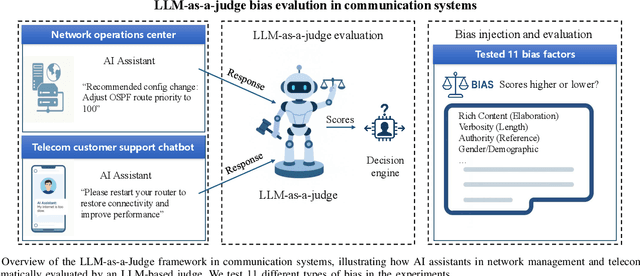
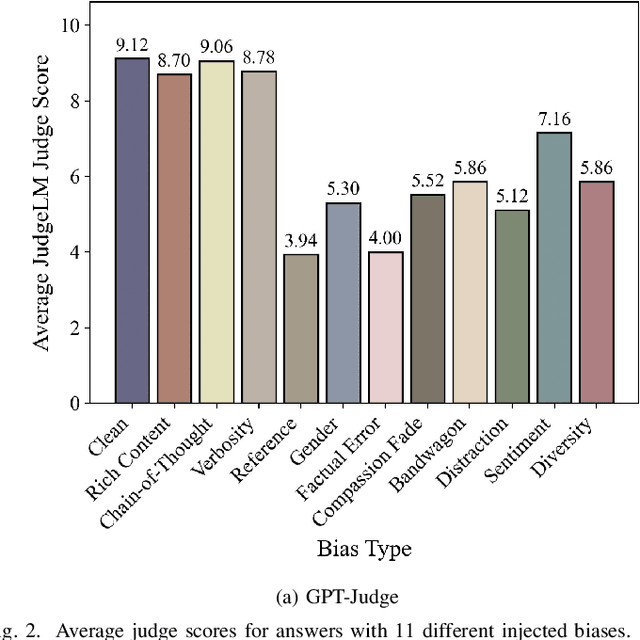
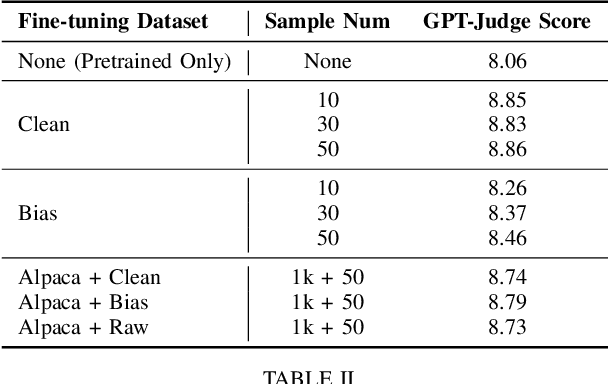
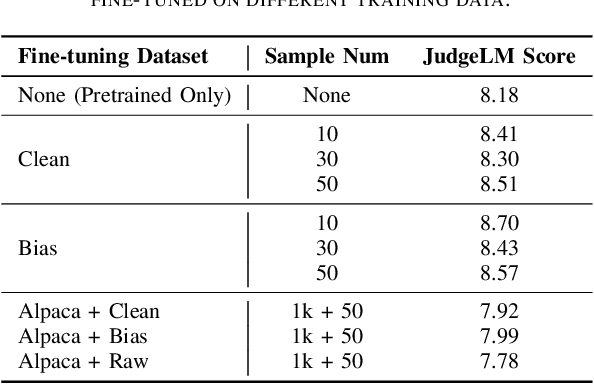
Abstract:Large Language Models (LLMs) are increasingly being used to autonomously evaluate the quality of content in communication systems, e.g., to assess responses in telecom customer support chatbots. However, the impartiality of these AI "judges" is not guaranteed, and any biases in their evaluation criteria could skew outcomes and undermine user trust. In this paper, we systematically investigate judgment biases in two LLM-as-a-judge models (i.e., GPT-Judge and JudgeLM) under the point-wise scoring setting, encompassing 11 types of biases that cover both implicit and explicit forms. We observed that state-of-the-art LLM judges demonstrate robustness to biased inputs, generally assigning them lower scores than the corresponding clean samples. Providing a detailed scoring rubric further enhances this robustness. We further found that fine-tuning an LLM on high-scoring yet biased responses can significantly degrade its performance, highlighting the risk of training on biased data. We also discovered that the judged scores correlate with task difficulty: a challenging dataset like GPQA yields lower average scores, whereas an open-ended reasoning dataset (e.g., JudgeLM-val) sees higher average scores. Finally, we proposed four potential mitigation strategies to ensure fair and reliable AI judging in practical communication scenarios.
Lethe: Purifying Backdoored Large Language Models with Knowledge Dilution
Aug 28, 2025Abstract:Large language models (LLMs) have seen significant advancements, achieving superior performance in various Natural Language Processing (NLP) tasks. However, they remain vulnerable to backdoor attacks, where models behave normally for standard queries but generate harmful responses or unintended output when specific triggers are activated. Existing backdoor defenses either lack comprehensiveness, focusing on narrow trigger settings, detection-only mechanisms, and limited domains, or fail to withstand advanced scenarios like model-editing-based, multi-trigger, and triggerless attacks. In this paper, we present LETHE, a novel method to eliminate backdoor behaviors from LLMs through knowledge dilution using both internal and external mechanisms. Internally, LETHE leverages a lightweight dataset to train a clean model, which is then merged with the backdoored model to neutralize malicious behaviors by diluting the backdoor impact within the model's parametric memory. Externally, LETHE incorporates benign and semantically relevant evidence into the prompt to distract LLM's attention from backdoor features. Experimental results on classification and generation domains across 5 widely used LLMs demonstrate that LETHE outperforms 8 state-of-the-art defense baselines against 8 backdoor attacks. LETHE reduces the attack success rate of advanced backdoor attacks by up to 98% while maintaining model utility. Furthermore, LETHE has proven to be cost-efficient and robust against adaptive backdoor attacks.
The Singapore Consensus on Global AI Safety Research Priorities
Jun 25, 2025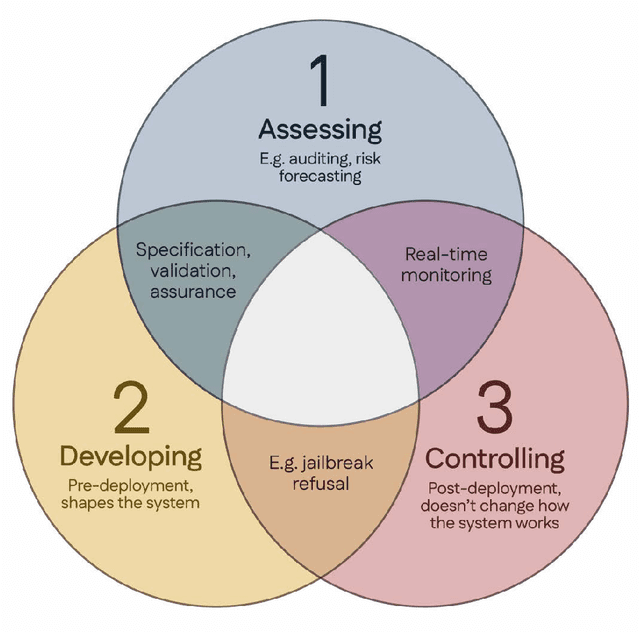
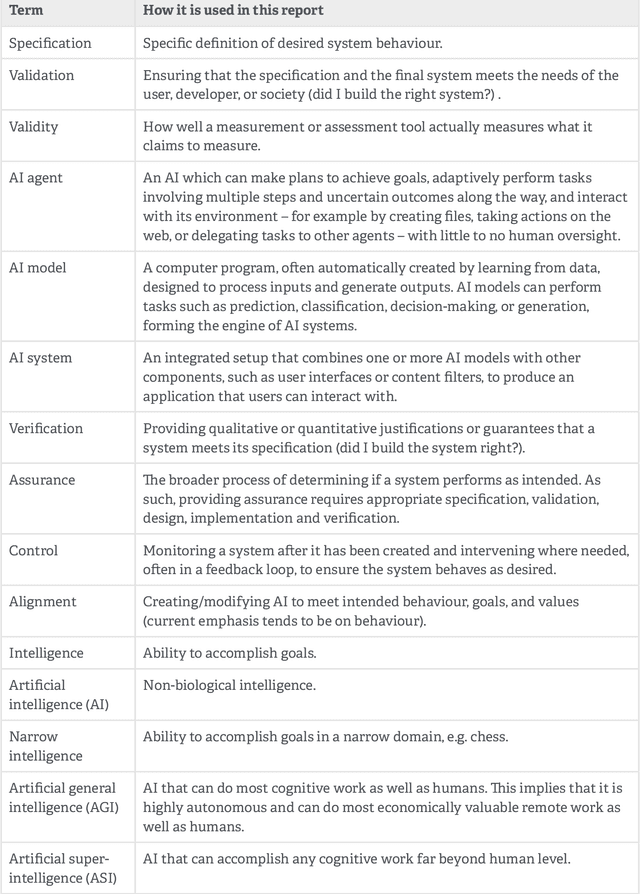
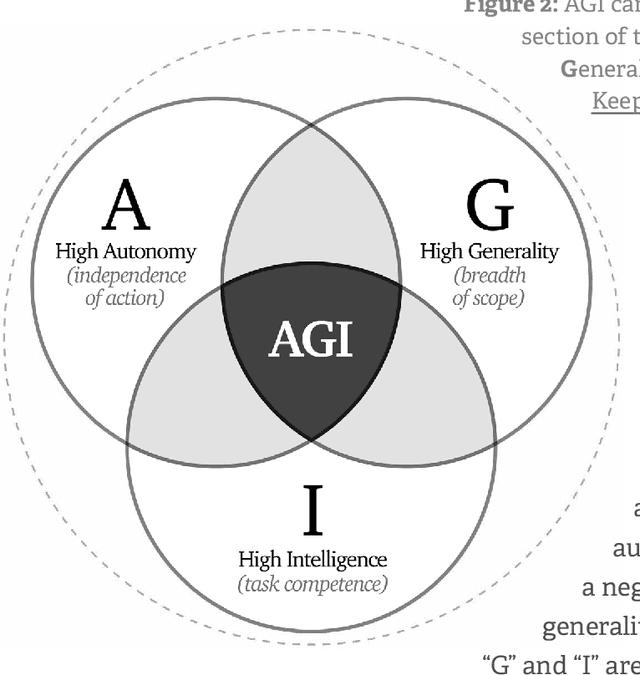
Abstract:Rapidly improving AI capabilities and autonomy hold significant promise of transformation, but are also driving vigorous debate on how to ensure that AI is safe, i.e., trustworthy, reliable, and secure. Building a trusted ecosystem is therefore essential -- it helps people embrace AI with confidence and gives maximal space for innovation while avoiding backlash. The "2025 Singapore Conference on AI (SCAI): International Scientific Exchange on AI Safety" aimed to support research in this space by bringing together AI scientists across geographies to identify and synthesise research priorities in AI safety. This resulting report builds on the International AI Safety Report chaired by Yoshua Bengio and backed by 33 governments. By adopting a defence-in-depth model, this report organises AI safety research domains into three types: challenges with creating trustworthy AI systems (Development), challenges with evaluating their risks (Assessment), and challenges with monitoring and intervening after deployment (Control).
Towards Comprehensive and Prerequisite-Free Explainer for Graph Neural Networks
May 20, 2025Abstract:To enhance the reliability and credibility of graph neural networks (GNNs) and improve the transparency of their decision logic, a new field of explainability of GNNs (XGNN) has emerged. However, two major limitations severely degrade the performance and hinder the generalizability of existing XGNN methods: they (a) fail to capture the complete decision logic of GNNs across diverse distributions in the entire dataset's sample space, and (b) impose strict prerequisites on edge properties and GNN internal accessibility. To address these limitations, we propose OPEN, a novel c\textbf{O}mprehensive and \textbf{P}rerequisite-free \textbf{E}xplainer for G\textbf{N}Ns. OPEN, as the first work in the literature, can infer and partition the entire dataset's sample space into multiple environments, each containing graphs that follow a distinct distribution. OPEN further learns the decision logic of GNNs across different distributions by sampling subgraphs from each environment and analyzing their predictions, thus eliminating the need for strict prerequisites. Experimental results demonstrate that OPEN captures nearly complete decision logic of GNNs, outperforms state-of-the-art methods in fidelity while maintaining similar efficiency, and enhances robustness in real-world scenarios.
Deep Learning Approaches for Anti-Money Laundering on Mobile Transactions: Review, Framework, and Directions
Mar 13, 2025Abstract:Money laundering is a financial crime that obscures the origin of illicit funds, necessitating the development and enforcement of anti-money laundering (AML) policies by governments and organizations. The proliferation of mobile payment platforms and smart IoT devices has significantly complicated AML investigations. As payment networks become more interconnected, there is an increasing need for efficient real-time detection to process large volumes of transaction data on heterogeneous payment systems by different operators such as digital currencies, cryptocurrencies and account-based payments. Most of these mobile payment networks are supported by connected devices, many of which are considered loT devices in the FinTech space that constantly generate data. Furthermore, the growing complexity and unpredictability of transaction patterns across these networks contribute to a higher incidence of false positives. While machine learning solutions have the potential to enhance detection efficiency, their application in AML faces unique challenges, such as addressing privacy concerns tied to sensitive financial data and managing the real-world constraint of limited data availability due to data regulations. Existing surveys in the AML literature broadly review machine learning approaches for money laundering detection, but they often lack an in-depth exploration of advanced deep learning techniques - an emerging field with significant potential. To address this gap, this paper conducts a comprehensive review of deep learning solutions and the challenges associated with their use in AML. Additionally, we propose a novel framework that applies the least-privilege principle by integrating machine learning techniques, codifying AML red flags, and employing account profiling to provide context for predictions and enable effective fraud detection under limited data availability....
Open Problems in Machine Unlearning for AI Safety
Jan 09, 2025Abstract:As AI systems become more capable, widely deployed, and increasingly autonomous in critical areas such as cybersecurity, biological research, and healthcare, ensuring their safety and alignment with human values is paramount. Machine unlearning -- the ability to selectively forget or suppress specific types of knowledge -- has shown promise for privacy and data removal tasks, which has been the primary focus of existing research. More recently, its potential application to AI safety has gained attention. In this paper, we identify key limitations that prevent unlearning from serving as a comprehensive solution for AI safety, particularly in managing dual-use knowledge in sensitive domains like cybersecurity and chemical, biological, radiological, and nuclear (CBRN) safety. In these contexts, information can be both beneficial and harmful, and models may combine seemingly harmless information for harmful purposes -- unlearning this information could strongly affect beneficial uses. We provide an overview of inherent constraints and open problems, including the broader side effects of unlearning dangerous knowledge, as well as previously unexplored tensions between unlearning and existing safety mechanisms. Finally, we investigate challenges related to evaluation, robustness, and the preservation of safety features during unlearning. By mapping these limitations and open challenges, we aim to guide future research toward realistic applications of unlearning within a broader AI safety framework, acknowledging its limitations and highlighting areas where alternative approaches may be required.
Artificial Intelligence without Restriction Surpassing Human Intelligence with Probability One: Theoretical Insight into Secrets of the Brain with AI Twins of the Brain
Dec 04, 2024



Abstract:Artificial Intelligence (AI) has apparently become one of the most important techniques discovered by humans in history while the human brain is widely recognized as one of the most complex systems in the universe. One fundamental critical question which would affect human sustainability remains open: Will artificial intelligence (AI) evolve to surpass human intelligence in the future? This paper shows that in theory new AI twins with fresh cellular level of AI techniques for neuroscience could approximate the brain and its functioning systems (e.g. perception and cognition functions) with any expected small error and AI without restrictions could surpass human intelligence with probability one in the end. This paper indirectly proves the validity of the conjecture made by Frank Rosenblatt 70 years ago about the potential capabilities of AI, especially in the realm of artificial neural networks. Intelligence is just one of fortuitous but sophisticated creations of the nature which has not been fully discovered. Like mathematics and physics, with no restrictions artificial intelligence would lead to a new subject with its self-contained systems and principles. We anticipate that this paper opens new doors for 1) AI twins and other AI techniques to be used in cellular level of efficient neuroscience dynamic analysis, functioning analysis of the brain and brain illness solutions; 2) new worldwide collaborative scheme for interdisciplinary teams concurrently working on and modelling different types of neurons and synapses and different level of functioning subsystems of the brain with AI techniques; 3) development of low energy of AI techniques with the aid of fundamental neuroscience properties; and 4) new controllable, explainable and safe AI techniques with reasoning capabilities of discovering principles in nature.
Hidden Data Privacy Breaches in Federated Learning
Nov 27, 2024



Abstract:Federated Learning (FL) emerged as a paradigm for conducting machine learning across broad and decentralized datasets, promising enhanced privacy by obviating the need for direct data sharing. However, recent studies show that attackers can steal private data through model manipulation or gradient analysis. Existing attacks are constrained by low theft quantity or low-resolution data, and they are often detected through anomaly monitoring in gradients or weights. In this paper, we propose a novel data-reconstruction attack leveraging malicious code injection, supported by two key techniques, i.e., distinctive and sparse encoding design and block partitioning. Unlike conventional methods that require detectable changes to the model, our method stealthily embeds a hidden model using parameter sharing to systematically extract sensitive data. The Fibonacci-based index design ensures efficient, structured retrieval of memorized data, while the block partitioning method enhances our method's capability to handle high-resolution images by dividing them into smaller, manageable units. Extensive experiments on 4 datasets confirmed that our method is superior to the five state-of-the-art data-reconstruction attacks under the five respective detection methods. Our method can handle large-scale and high-resolution data without being detected or mitigated by state-of-the-art data reconstruction defense methods. In contrast to baselines, our method can be directly applied to both FedAVG and FedSGD scenarios, underscoring the need for developers to devise new defenses against such vulnerabilities. We will open-source our code upon acceptance.
 Add to Chrome
Add to Chrome Add to Firefox
Add to Firefox Add to Edge
Add to Edge